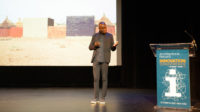For Ryue Nishizawa and Kazuyo Sejima, principals of the Pritzker Prize-winning firm SANAA, innovation can occur long before a building is designed. The program for Grace Farms (which opened last weekend in New Canaan, Connecticut) required just such creativity.
“It’s got a large place for eating, but it’s not a restaurant,” Sejima said. “It’s got a gym, but it’s not a sports center. It’s got rooms for reading, but it’s not a library. It’s a new kind of public space.”
Sejima and Nishizawa spoke at Architectural Record’s biannual Innovation Conference, “Expanding Architecture: Creativity + Design + Technology,” which was held in Manhattan’s Time & Life Building. She told the 400 architects in attendance that an earlier SANAA project, the Rolex Learning Center in Lausanne, Switzerland, “doesn’t do enough to communicate with its surroundings.” So before designing Grace Farms, she and Nishizawa spent many days walking the site, trying to make sure the building would “communicate with nature.”
Other architects have found innovative ways to present designs to clients. Chad Oppenheim, a Miami-based architect, described his use of video game technology to create hyper-realistic renderings, which the viewer can control in real time like the most sophisticated games (and which won over his client Michael Bay, the director of actions films like Armageddon). “I think you’ll see a fusion of architecture and gaming in the next five years,” Oppenheim said.
By contrast, Nicolas Moreau and Hiroko Kusunoki, of Paris-based Moreau Kusunoki, showed a series of hand-drawn renderings, disarming in their apparent simplicity, that helped the couple win the competition to design the proposed Guggenheim Museum Helsinki. Both just 36 years old, they have also won competitions for a courthouse in Paris, a museum of culture in Guyana, and an engineering school in the French Alps. If Oppenheim is constrained by computing power, Kusunoki is limited only by the thinness of the point on her Sakura Micron pen.
The conference opened with Gregg Pasquarelli, a principal of SHoP Architects, describing uses of technology that have helped his firm speed the transition from design to construction. When its Barclays Center in Brooklyn was rising, he said, “our guys were up in the steel, with iPads. The steelworkers didn’t want drawings; they wanted to see the models, which our guys could spin around for them onscreen.” The firm is also proud of its innovative forms. Its supertall condo building at 111 West 57th Street in Manhattan will culminate in a 200-foot spire that Pasquarelli said has no function other than to be “a piece of beauty in the air.” And its nearly windowless east and west facades will be covered in sinuous terra cotta panels that hint of tradition, even at dizzying heights.
Deborah Berke, who was recently named dean of the Yale School of Architecture, showed some of the work of her Manhattan practice, Deborah Berke Partners. “The alchemy of architecture is making common things precious,” said Berke, describing a series of adaptive re-use projects that brought “magic” to formerly workaday buildings. Architecture, she said, “is not problem solving. What it is really about making something that expresses your beliefs.”
Senior leaders of Perkins + Will, Kohn Pedersen Fox Associates and Gensler talked about ways very large firms can foster innovation and creativity. Ed Feiner, director of the Design Leadership Council at Perkins + Will, described initiatives meant to engage the youngest members of the 26-office practice, including an internal competition that recently attracted 62 teams. “Senior people are not necessarily seeing all the perspectives,” he said. Diane Hoskins, co-CEO of Gensler, said that the route to innovation is harnessing diversity, having “people who are different from each other come together to solve problems.”
James von Klemperer, president and design principal of KPF, said that compared to their Silicon Valley counterparts, architects tend to innovate incrementally. Michael Bierut, the preeminent graphic designer, recommended saving innovation for where it’s really needed. He told the crowd: “Show up; pay attention; if you look hard and listen hard, the answer will be waiting.” One audience member suggested that innovation shouldn’t be an end in itself. But Cathleen McGuigan, RECORD’s editor-in-chief, had a simple answer. “Innovation,” she said, “is embedded in good work.”





















